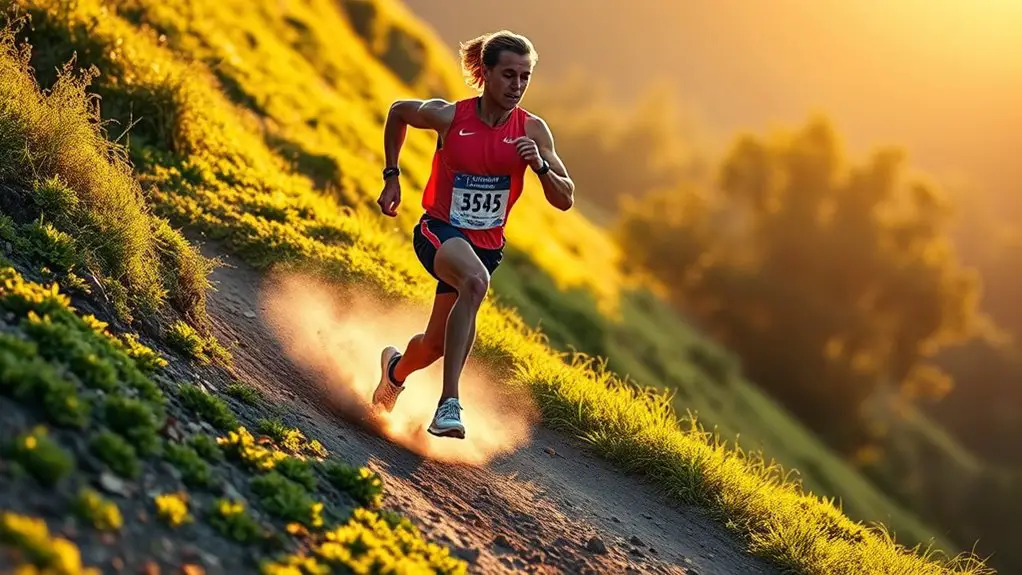Sled training boosts your acceleration in any sport by enhancing your strength and explosive power. It helps you engage multiple muscle groups while improving core stability. With proper technique, you can optimize force application, giving you a quicker push-off and greater propulsion. Additionally, sled workouts are low-impact, reducing injury risks while increasing performance. Knowing how to effectively incorporate sled training can make a significant difference in your athletic development—there's more to discover about these techniques!
Understanding the Mechanics of Acceleration
When you think about acceleration in sports, it's essential to understand the mechanics behind it. Acceleration mechanics play a significant role in your performance, allowing you to release your potential on the field or court. It all starts with force application—how you push against the ground. The greater the force you generate, the faster you can propel yourself forward.
Your body acts like a spring, storing energy in your muscles and tendons. When you engage those muscles explosively, the stored energy discharges, resulting in rapid acceleration. This process isn't just about raw strength; it's about timing and technique. Proper form helps optimize your force application, ensuring you maximize your speed without compromising your safety. Incorporating plyometric exercises for explosiveness can significantly enhance your acceleration capabilities.
The Benefits of Sled Training for Strength and Power
Sled training can markedly enhance your strength and power, both of which are vital for improving acceleration. By incorporating sled mechanics into your resistance training routine, you'll build explosive strength and develop the fast-twitch muscle fibers essential for performance in any sport. Here's a quick overview of the benefits:
| Benefit | Explanation | Impact on Performance |
|---|---|---|
| Increased Strength | Builds overall muscle strength | Enhances push-off power |
| Improved Power | Develops explosive power through resistance | Boosts acceleration and speed |
| Enhanced Endurance | Engages multiple muscle groups for longer workouts | Sustains effort in competitions |
| Core Stability | Strengthens the core during sled pulls/pushes | Improves overall athletic balance |
| Joint Health | Low-impact, safe way to strengthen joints | Reduces injury risk |
Embrace sled training, and you'll reveal your potential, gaining strength and power that translates directly to better acceleration on the field or court. Additionally, incorporating squat variations into your routine can further enhance your lower body strength, crucial for explosive movements.
Techniques for Effective Sled Pulls and Pushes
To maximize your sled pulls and pushes, focus on proper body positioning and maintaining ideal resistance levels. You'll want to incorporate explosive movement techniques to really boost your acceleration. Let's explore how these elements can enhance your training.
Proper Body Positioning
Achieving proper body positioning is essential for maximizing the effectiveness of sled pulls and pushes. You want to maintain ideal body alignment to guarantee that your movements are efficient and powerful. Start by keeping your head up and your chest out, which promotes good posture control. Your hips should be slightly lower than your shoulders, creating a strong base for explosive strides. When pulling, lean into the sled, driving through your legs while keeping your core engaged. For pushes, adopt a low stance, using your arms to drive the sled forward while your legs power through. By focusing on these positions, you'll cultivate the freedom of movement necessary to enhance your acceleration across all sports.
Optimal Resistance Levels
Maintaining proper body positioning is just the start; choosing the right resistance level is key for effective sled pulls and pushes. You'll want to experiment with sled weight to find the sweet spot that challenges you without sacrificing form. Too much resistance can lead to poor technique, while too little won't push your limits. Make gradual resistance adjustments to hone in on what feels right for your current strength and speed. Start light, then progressively add weight as you build confidence and power. Remember, the goal is to enhance your acceleration, not to struggle against an overwhelming load. Find that balance, and you'll release your true potential while enjoying the freedom of movement that sled training provides.
Explosive Movement Techniques
While proper resistance levels are important, mastering explosive movement techniques during sled pulls and pushes is essential for maximizing your acceleration. Incorporate explosive drills and plyometric exercises to develop your speed and power. Here are some key techniques to focus on:
| Technique | Description | Benefits |
|---|---|---|
| Quick Starts | Short bursts of speed from a stop | Enhances reaction time |
| Low-Load Pushes | Light resistance for rapid movement | Improves explosiveness |
| High-Knee Drives | Emphasizes knee lift during pulls | Boosts acceleration |
| Side Sled Pulls | Engage lateral muscles | Increases agility |
Sled Training for Different Sports: A Versatile Approach
Sled training can be tailored to meet the unique needs of various sports, enhancing your performance where it counts. By focusing on sport-specific adaptations, you'll not only build strength and power but also reduce the risk of injury. This versatility makes sled training an invaluable tool for athletes across all disciplines.
Sport-Specific Adaptations
When athletes incorporate sled training into their routines, they can tailor their workouts to target the specific demands of their sport. This versatility means you can design sport-specific drills that not only enhance acceleration but also boost agility improvements. Here's a quick look at how sled training can adapt to different sports:
| Sport | Focus Area | Suggested Drill |
|---|---|---|
| Soccer | Speed and Agility | Sled sprints with cuts |
| Football | Explosive Power | Starting block pushes |
| Track & Field | Acceleration | Resistance sprints |
Strength and Power Gains
Incorporating sled training not only enhances sport-specific skills but also greatly contributes to strength and power gains across various athletic disciplines. By engaging in this dynamic form of strength training, you'll reveal your potential and experience transformative power development.
- Feel the rush of raw strength as you push against resistance.
- Experience explosive power that translates into on-field performance.
- Discover newfound freedom in your movement and agility.
- Embrace the confidence that comes from knowing you're stronger than ever.
Sled training challenges your body in ways traditional workouts can't, igniting muscle fibers and building functional strength. So, if you're ready to elevate your game, sled training is your ticket to achieving unparalleled strength and power!
Injury Prevention Benefits
While many athletes focus on strength and power, sled training also plays an essential role in injury prevention. By engaging multiple muscle groups and promoting balanced development, sled training enhances muscle resilience, making you less prone to injuries. This form of training emphasizes proper biomechanics, which can reduce the risk of strains and sprains during competition. Plus, sled training helps with injury recovery; by strengthening supporting muscles and improving joint stability, you can bounce back faster when setbacks occur. You'll find that the combination of acceleration and resistance work not only boosts your performance but also fortifies your body against potential injuries. Embrace sled training to unleash your athletic potential and maintain your freedom to play without fear of injury.
Integrating Sled Training Into Your Workout Routine
Although many athletes focus on traditional strength and conditioning methods, integrating sled training into your workout routine can greatly enhance your acceleration and overall performance. A sled workout not only builds strength but also ignites a sense of freedom in your movement. To make the most of this powerful training tool, consider the following tips for your training schedule:
- Start with lighter weights to perfect your form before adding resistance.
- Incorporate sled sprints into your speed workouts, alternating with traditional drills.
- Use the sled for both pushing and pulling exercises to engage different muscle groups.
- Schedule sled sessions 2-3 times a week for ideal results without overtraining. Incorporating plyometric exercises can further boost your explosive strength and speed.
Real-Life Success Stories: Athletes Who Excelled With Sled Training
Many elite athletes have harnessed the power of sled training to boost their acceleration and performance, proving its effectiveness in real-world scenarios. Take, for instance, a track sprinter who credits sled pulls for shaving essential milliseconds off their time. They've shared athlete testimonials that highlight how pushing sleds not only increased speed but also improved their overall strength.
Similarly, a football player transformed their explosive power through sled training, leading to better on-field performance and reduced injuries. Their training experiences reveal that sled work enhances both physical and mental resilience, giving them the freedom to perform at their peak. This aligns with the understanding that explosive power is crucial for high-level athletic performance.
These stories underscore the versatility of sled training across various sports. When you embrace sled training, you're not just adopting a workout; you're joining a community of athletes who've discovered newfound acceleration and confidence. So, why not take a cue from these success stories and give sled training a try?
Frequently Asked Questions
Can Sled Training Reduce the Risk of Injuries in Athletes?
Yes, sled training can definitely help reduce the risk of injuries in athletes. By focusing on strength and stability, it enhances muscle coordination, which aids in injury prevention. Plus, the low-impact nature of sled training means you can push your limits without putting undue stress on your joints. This not only promotes effective athlete recovery but also builds a solid foundation to help you perform better and stay injury-free in your sport.
How Often Should I Incorporate Sled Training Into My Routine?
Incorporating sled training into your routine is like adding a turbocharger to your engine—it can greatly boost your performance. Aim for 1-3 sessions per week, depending on your goals and recovery. This sled frequency allows you to reap the training benefits without overdoing it. Listen to your body; if you feel fatigued, take a step back. Balance is key, ensuring you enjoy your training while making strides in your athletic journey.
What Age Group Can Safely Start Sled Training?
You might be wondering when youth athletes can safely start sled training. Generally, kids as young as 12 can begin, provided they follow proper training guidelines and focus on technique. It's crucial to confirm they're physically mature enough and have a solid foundation in strength training. This way, they can enjoy the freedom of pushing their limits safely, enhancing their skills without risking injury. Always consult a coach or trainer for personalized advice!
Are There Specific Sled Types for Different Sports?
You'd think all sleds are the same, right? Well, not quite! Different sports demand specific sled designs tailored for sport specificity. For instance, a wider sled might be perfect for football players, offering stability during intense pushes, while a lighter sled could benefit sprinters, enhancing speed without excess weight. So, choosing the right sled for your sport can truly set you free and elevate your training to new heights.
How Long Does It Take to See Results From Sled Training?
You'll typically start seeing results from sled training within a few weeks, but it really depends on your training frequency. If you're consistent and push yourself, you might notice improvements in strength and acceleration sooner. Keep in mind, everyone's different, so your results timeline could vary. Stay committed, enjoy the process, and you'll find that freedom in movement and performance you're aiming for. Embrace the journey and trust your progress!




